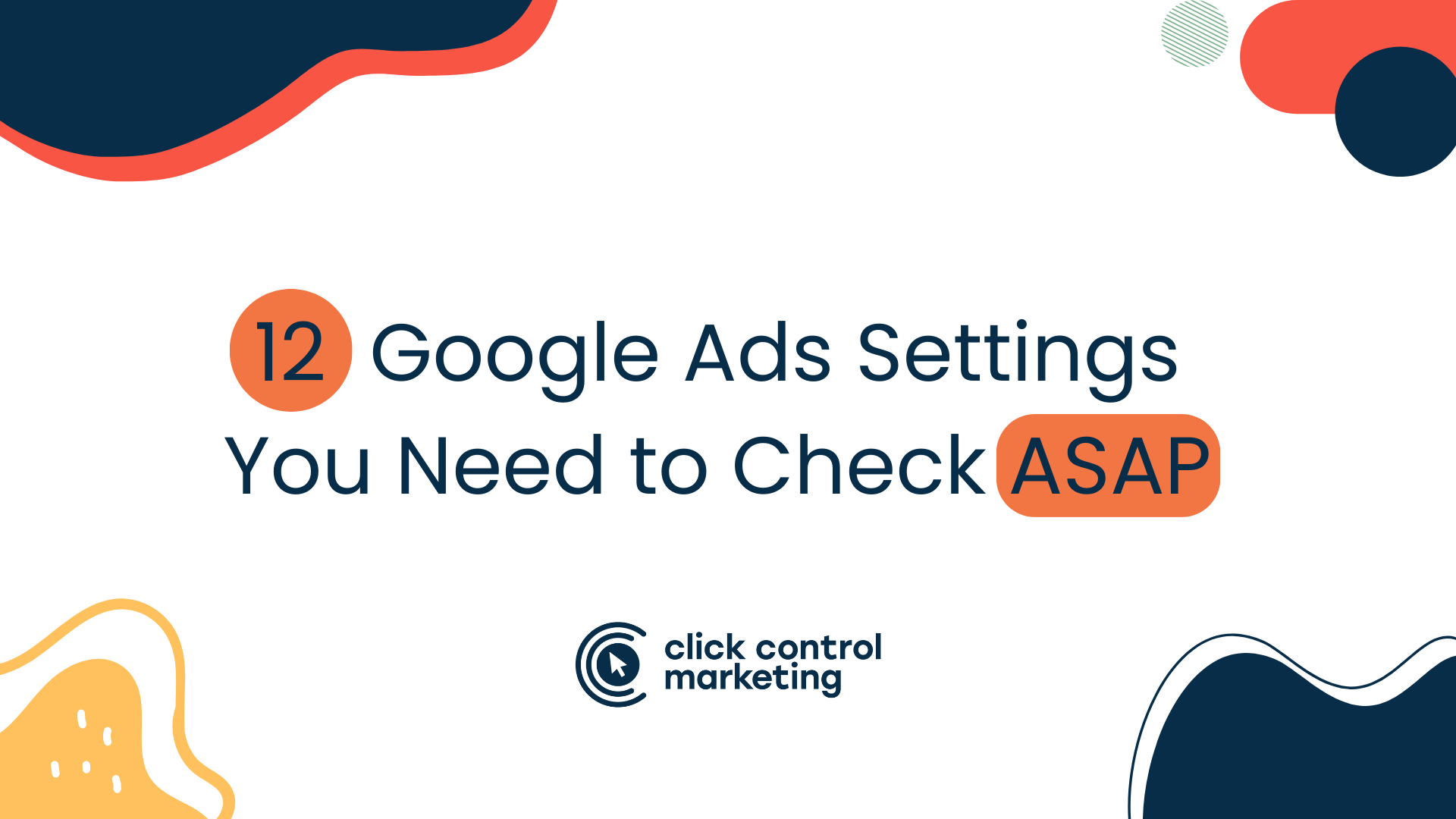Many Google Ads campaigns are wrecked from a lack of attention to basic settings. From neglecting location settings to missing campaign end dates, vast amounts of ad spend can be wasted if you’re not careful. So it’s essential to regularly review and adjust your settings to optimize your advertising success. Here are 12 of the most important settings you should check in your Google Ads account:
- Location targeting settings
This setting allows you to target or exclude certain geographic locations. You can serve your ads nationally, regionally, or locally. A mistake many advertisers make is targeting nationally when they can only take local customers. Or if you live in a large metroplex, such as Houston, someone on the other end of the city may or may not be willing to drive to your location, which means you’ll want to only target the segment of the city that will actually find your offering worth the drive.
That’s why it is imperative to regularly check and update location targeting settings in digital advertising. This is because location targeting determines which audience will see the ad and how often it will be displayed. Inaccurate location targeting can lead to wasted marketing budget and decreased ROI. Thankfully, location targeting provides advertisers with the ability to target highly specific audiences, increasing the likelihood of conversions and engagement. Therefore, regularly checking and updating location targeting settings can greatly enhance the effectiveness of your Google Ads campaigns.
- Network settings for ads
Ensuring your ads reach the right audience is crucial to the success of any advertising campaign. One surefire way to monitor and optimize your ad delivery is to check your network settings for several different networks: Search, Display, and Video. Your network settings determine which sites your ads are displayed on to ensure that your ads are reaching the right people in the right places. Each of these networks presents unique opportunities to reach potential customers in specific ways.
The Search network, for instance, allows advertisers to display their ads to individuals who are actively searching for specific keywords related to their product or service, while the Display network offers a broad range of ad formats and targeting options to reach customers at various stages of the buying cycle. Finally, the Video network is ideal for reaching users with engaging, multimedia ad content across YouTube and the Google Display Network. By paying close attention to your ad settings on each of these networks, you can optimize your ad delivery and ensure your ads are reaching the right people in the right places, leading to more successful and profitable advertising campaigns.
- Audience expansion settings
Your audience expansion settings allow you to target similar audiences who are more likely to be interested in your ads. You can use this setting to expand the reach of your campaigns and increase engagement from potential customers.
With the help of audience expansion settings, advertisers have the opportunity to boost their ad reach by targeting audiences that are similar to their ideal customer base. By selecting this feature, advertisers can leverage their existing data to identify highly-engaged and relevant users who are more likely to convert into paying customers. Additionally, audience expansion settings enable advertisers to expand their reach beyond their initial target audience and tap into new markets. This, in turn, helps to drive higher levels of engagement and conversions, resulting in better return on investment for advertisers. It is important to regularly check and adjust your audience expansion settings to ensure that you are targeting the most relevant and profitable audience segments based on your ongoing campaign performance and business goals.
- Auto-applied recommendations
Google Ads’ auto-applied recommendations feature allows you to apply recommended changes in your account without having to manually adjust the settings yourself. Auto-applied recommendations in Google Ads can be an enticing feature for advertisers looking to optimize their campaigns with minimal effort. However, these automated recommendations can pose significant risks to ad performance and budget management.
Google’s automation algorithms are designed to maximize ad spend rather than achieve campaign-specific goals. As a result, the auto-applied recommendations may not align with the advertiser’s objectives, leading to wasted ad spend and lower return on investment. Moreover, these recommendations can be implemented without considering key factors such as audience targeting and messaging relevance, leading to decreased ad quality. Advertisers must exercise caution when considering auto-applied recommendations and thoroughly assess how the recommendations align with their campaign goals and overall strategy. A more strategic approach, combining automation with human oversight, can help maximize the benefits while minimizing the dangers of Google Ads’ auto-applied recommendations.
- Auto applied assets
The auto-applied assets setting allows you to automatically add images, videos, and other content to your ads. This is a great way to quickly improve the quality of your ad campaigns without having to do any additional work. Auto-applied assets are incredibly advantageous in Google Ads campaigns as they can save advertisers valuable time and resources. By using machine learning technology, Google Ads can automatically apply high-quality images and compelling headlines to an ad, removing much of the creative burden from the advertiser. This allows them to focus on other important aspects of the campaign, such as targeting and bidding strategies. By leveraging machine learning technology, auto-applied assets can be a powerful tool in an advertiser’s arsenal, helping them to create more effective and efficient ad campaigns.
- Dynamic search ads
Dynamic search ads (DSAs) enable you to target potential customers based on the content of their query. These ads are a great tool for advertisers who want to reach a wide audience through a more efficient and automated process. This helps ensure that your ads are being shown to people who are more likely to be interested in what you have to offer.
One of the main benefits of DSAs is that they allow advertisers to automatically generate highly relevant ads based on the content of their website. This means that every time a potential customer searches for a relevant product or service, Google’s algorithm matches queries to search terms on the advertiser’s website and creates a targeted ad in real-time. By utilizing this feature, businesses can save time and resources. Additionally, DSAs provide valuable insight into the search terms that are driving traffic to the website, helping advertisers to refine their strategy and focus on the most successful keywords. All in all, dynamic search ads are a powerful tool for streamlining and improving digital advertising campaigns, resulting in increased ROI, greater visibility, and higher conversion rates.
- Content exclusions
Content exclusions allow you to specify which websites and apps your ads should not be served on. This is helpful for avoiding irrelevant placements and making sure that your ads are being seen in the right places. Content exclusions are an invaluable tool for advertisers when it comes to ensuring the maximum effectiveness of Google Ads campaigns. By allowing you to specify which sites and apps your ads should not appear on, content exclusions give you the freedom to avoid any irrelevant placements that could dilute the impact of your messaging and decrease conversion rates.
In addition, content exclusions allow for greater brand safety by ensuring that your ads are not shown alongside content that could be inappropriate or damaging for your brand. This level of control is particularly important for businesses operating in sensitive sectors or industries. Content exclusions offer a huge boost to the effectiveness and ROI of your advertising efforts.
- Campaign start/end dates
Your campaign start and end dates define when your ads will begin running and when they’ll stop. Google Ads allows advertisers to choose the exact dates and times that their campaigns will be active. With this feature, advertisers can strategically launch their ad campaigns during peak sales seasons and special events or end campaigns after they have reached their desired goals. Setting start and end dates is a crucial step that can save advertisers time and money by preventing unnecessary ad expenditures beyond a specified date.
Advertisers can also run their ads continuously without any end date, making it an ongoing strategy for building brand awareness and increasing conversions. In short, campaign start and end dates are essential variables that allow advertisers to manage their campaigns and budgets effectively and reach their target audience efficiently.
- Ad rotation settings
Your ad rotation settings determine how often each ad in an ad group is served. You can use this setting to test which ads perform best and ensure that your campaigns are optimized for maximum success.
Ad rotation settings in Google Ads gives advertisers the ability to determine which ads are being served and how often. Advertisers can experiment with different ad variations and ensure that their campaigns are optimized for maximum success. This feature is particularly useful for testing different ad copies, images, or videos within an ad group to ascertain which ones perform better. Ad rotation also helps to prevent one ad from dominating the campaign and consuming all the advertising budget. Instead, it distributes it more equally across all ads, thereby giving each an opportunity to succeed. By enabling ad rotation settings, advertisers can make informed decisions about which ads are the most effective and maximize their investment on the most successful ones.
- Language settings
In Google Ads, language settings play a vital role in the success of your ad campaigns. Through language settings, you can select which languages and regions your ads will be served to. This is crucial in ensuring that your ads are reaching the right audience and driving maximum engagement. With Google Ads, you have the ability to target specific languages or regions, or even multiple languages simultaneously. It allows you to tailor your ads to a specific audience, which is particularly useful for businesses that operate globally or in multilingual regions.
Additionally, Google Ads provides language-specific bidding options that enable you to adjust your bids based on the language or region you’re targeting. This allows you to optimize your campaigns for maximum return on investment. By tweaking your language settings in Google Ads, you can take full advantage of the platform’s targeting capabilities and ensure that you’re effectively reaching your audience.
- Bid adjustment settings
Bid adjustment settings are a useful tool in Google Ads that allow advertisers to adjust their bids based on various factors, such as device type, time of day, location, and more. However, despite their potential benefits, bid adjustment settings can often fail to produce the desired results, resulting in lower performance and wasted ad spend. One of the main reasons for this is the complexity of bid adjustment settings, which can be difficult to set up correctly and can easily lead to overbidding or underbidding. Additionally, bid adjustment settings can be influenced by external factors such as changes in user behavior, competition levels, and more, making it difficult to maintain consistent performance over time.
To avoid these issues, it is important to regularly monitor your bid adjustment settings and make adjustments as necessary to ensure that your ads are performing as effectively as possible. This is why it’s important to keep an eye on your bid adjustment settings and make sure that they’re working as intended. If not, consider adjusting them or turning them off altogether.
- Final URL expansion (PMAX only)
This setting is only available for campaigns using the PMAX bidding strategy. It allows you to expand your ad’s final URL, so that the landing page can be optimized for maximum performance. Final URL expansion is a feature available exclusively on PMAX in Google Ads that is designed to help advertisers more effectively manage their ad campaigns. This tool enables advertisers to dynamically create and optimize URLs within their ads, allowing them to provide more specific page destinations for customers clicking on their ads. With final URL expansion, PMAX users can make custom landing pages or link groups of ads to one landing page to increase the relevance of their ads to the audience, ultimately driving higher click-through rates and conversion rates for their campaigns. By leveraging this feature, advertisers can also gain deeper insights into how customers interact with their ads and pinpoint areas for optimization, resulting in more effective ad campaigns, deeper customer engagement, and ultimately greater revenue growth. Overall, final URL expansion is a valuable tool in the arsenal of any PMAX user who wants to maximize their ad campaign results through advanced optimization techniques.
Conclusion
These are just some of the essential Google Ads settings you need to check in your account. Regularly reviewing your settings is a crucial component of ensuring that your Google Ads campaigns are optimized for maximum performance. Keep these 12 settings in mind when optimizing your account and you’ll be well on your way to achieving great results!







